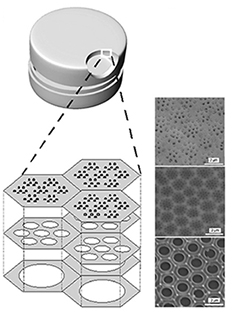project34:Performance
The structural morphology of the project is derived from diatoms, a major group of algae. They exist as unicellular organisms, but often form colonies. The global and local articulation of their unique cell wall made of silica (hydrated silicon dioxide) is the main point of reference here.
Global Geometry
Diatom frustules are often dome-like or rounded to form structures of minimal weight and material usage that handle compression loads of fluid pressure and point-compression loads of predators efficiently. Individual cells connect to form colonies with 'wrench-shaped, overlapping, interlocking spines' that can slide over each other to form linear and curvilinear global configurations.
Local Geometry
Inspite of being constituted of an extremely brittle material, silica, because of their formal articulation these cell walls exhibit exceptional mechanical strength. Each 'panel' in the frustule has complex hierarchical organization of layers with varying pore sizes. The central layer is often hexagonal, given the high compression resistance with minimal weight of honeycomb like structures.
Material

